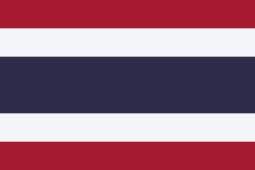ಥೈಲ್ಯಾಂಡ್ ನ ರಾಷ್ಟ್ರಧ್ವಜ
ಗೋಚರ
 | |
| ಹೆಸರು | Trairanga (ಥಾಯ್:ธงไตรรงค์, RTGS: Thong Trairong), "Tricolour flag" |
|---|---|
| ಬಳಕೆ | National flag, civil and state ensign |
| ಅನುಪಾತ | 2:3 |
| ಸ್ವೀಕರಿಸಿದ್ದು | 28 September 1917 |
| ವಿನ್ಯಾಸ | Five horizontal stripes of red, white, blue, white and red, the middle stripe twice as wide as the others |
| ವಿನ್ಯಾಸಗೊಳಿಸಿದವರು | King Vajiravudh (Rama VI) |
 Variant flag of Thailand | |
| ಹೆಸರು | ಥಾಯ್:ธงราชนาวี (RTGS: Thong Ratchanawi), "Royal Navy flag" |
| ಬಳಕೆ | Naval Ensign and diplomatic flag |
| ಅನುಪಾತ | 2:3 |
| ಸ್ವೀಕರಿಸಿದ್ದು | 28 September 1917 |
| ವಿನ್ಯಾಸ | A red disc containing a white elephant in regalia centred on the national flag |
ಥೈಲ್ಯಾಂಡ್ ಸಾಮ್ರಾಜ್ಯದ ಧ್ವಜ (ಥಾಯ್: ธง ไตรรงค์, ಥೊಂಗ್ ಟ್ರೈರಾಂಗ್, "ತ್ರಿವರ್ಣ ಧ್ವಜ") ಕೆಂಪು, ಬಿಳಿ, ನೀಲಿ, ಬಿಳಿ ಮತ್ತು ಕೆಂಪು ಬಣ್ಣದ ಐದು ಸಮತಲ ಪಟ್ಟೆಗಳನ್ನು ತೋರಿಸುತ್ತದೆ. ಅದೇ ನಾಲ್ಕು ವರ್ಷಗಳಲ್ಲಿ ರಾಮ VI ರವರು ನೀಡಿದ ರಾಯಲ್ ಡಿಕ್ರೀಯ ಪ್ರಕಾರ, ೧೯೧೭ ರ ಸೆಪ್ಟೆಂಬರ್ ೨೮ ರಂದು ಈ ವಿನ್ಯಾಸವನ್ನು ಅಳವಡಿಸಲಾಯಿತು.ಆ ದಿನವು ೨೦೧೬ ರಿಂದ ರಾಷ್ಟ್ರದ ಧ್ವಜವನ್ನು ಆಚರಿಸುವ ಥೈಲ್ಯಾಂಡ್ನಲ್ಲಿ ರಾಷ್ಟ್ರೀಯ ರಜಾದಿನವಾಗಿದೆ.[೧]ಥಾಯ್:ธงไตรรงค์
ಬಣ್ಣಗಳು ರಾಷ್ಟ್ರ-ಧರ್ಮ-ಅರಸ ಇವುಗಳನ್ನು ಸೂಚಿಸುತ್ತದೆ, ಇದು ಥೈಲ್ಯಾಂಡ್ನ ಅನಧಿಕೃತ ಧ್ಯೇಯ, ಭೂಮಿ ಮತ್ತು ಜನರಿಗೆ ಕೆಂಪು, ಧರ್ಮಗಳಿಗೆ ಬಿಳಿ ಮತ್ತು ರಾಜಪ್ರಭುತ್ವಕ್ಕೆ ನೀಲಿ, ಕೊನೆಯದಾಗಿ ರಾಮ VI ನ ಮಂಗಳಕರ ಬಣ್ಣವನ್ನು ಹೊಂದಲಾಗಿದೆ. ರಾಜ ಜರ್ಮನಿಯ ಮೇಲೆ ಜುಲೈ ಘೋಷಿಸಿದಂತೆ, ಕೆಲವು ಧ್ವಜವು ಬ್ರಿಟನ್, ಫ್ರಾನ್ಸ್, ರಷ್ಯಾ ಮತ್ತು ಯುನೈಟೆಡ್ ಸ್ಟೇಟ್ಸ್ನಂತೆಯೇ ಅದೇ ಬಣ್ಣದ ಬಣ್ಣವನ್ನು ಹೊಂದಿದೆ. [೨]
ಇವುಗಳನ್ನು ಸಹ ನೋಡಿ
[ಬದಲಾಯಿಸಿ]ಉಲ್ಲೇಖಗಳು
[ಬದಲಾಯಿಸಿ]- ↑ (in Thai)ಟೆಂಪ್ಲೇಟು:Th icon การฉลองครบรอบ 100 ปี การประกาศใช้ธงไตรรงค์ เป็นธงชาติไทย Archived 2017-05-19 ವೇಬ್ಯಾಕ್ ಮೆಷಿನ್ ನಲ್ಲಿ. Retrieved September 26, 2017.
- ↑ Duncan Stearn (14–20 February 2003). "A Slice of Thai History: Raising the standard; Thailand's national flags". Pattaya Mail. Retrieved 24 July 2011.
The prevailing – although unofficial – view of the meaning of the five stripes is that red represents the land and the people; the white is for Theravada Buddhism, the state religion and the central blue stripe symbolises the monarchy. It has also been stated that blue was the official colour of King Rama VI. Another account claims the blue was inserted as a show of solidarity following Thailand's entry into the First World War (in July 1917) as an ally of Britain and France.
